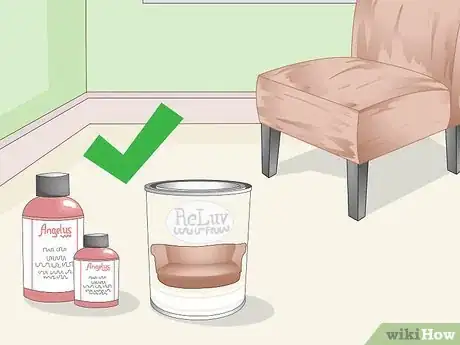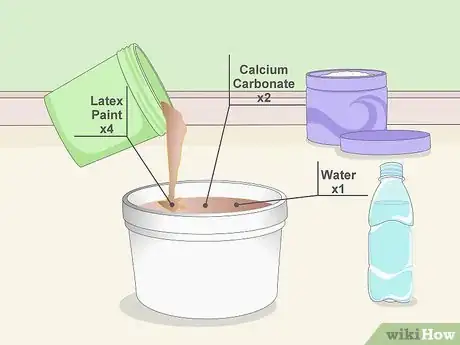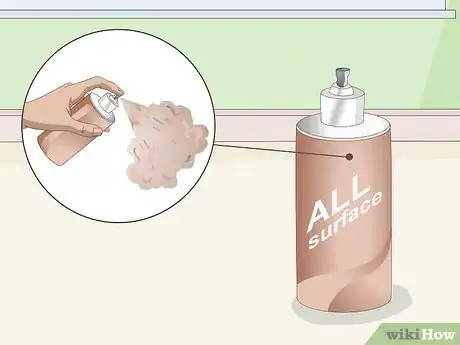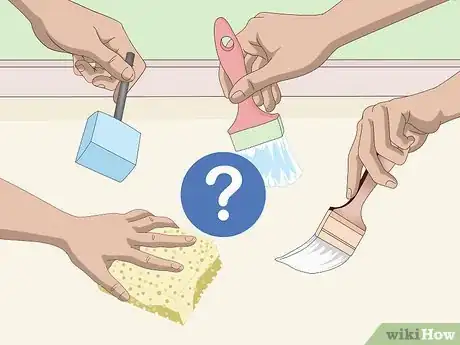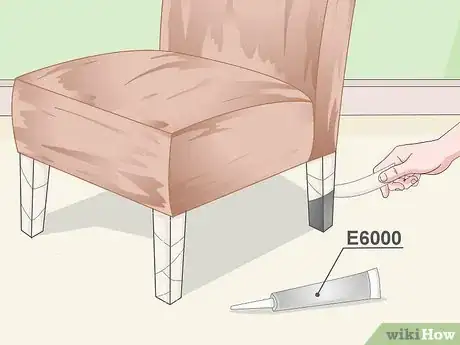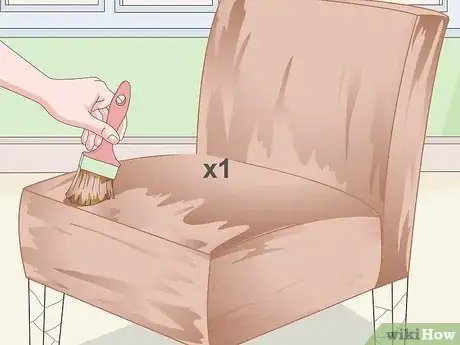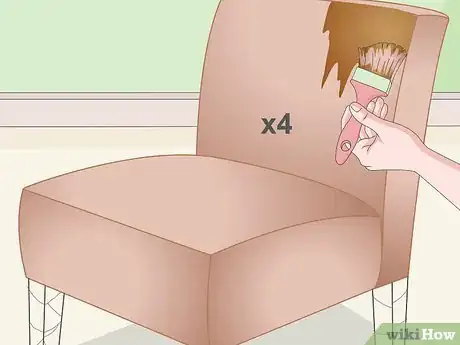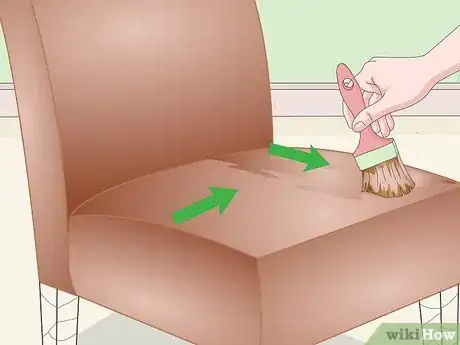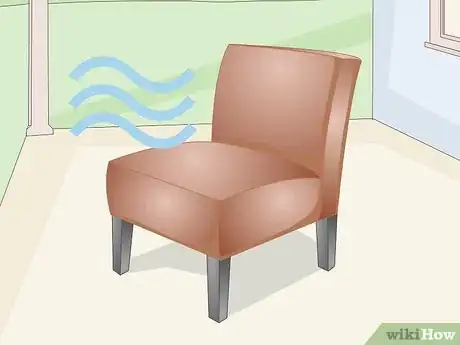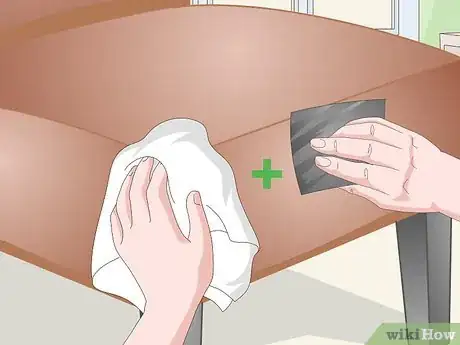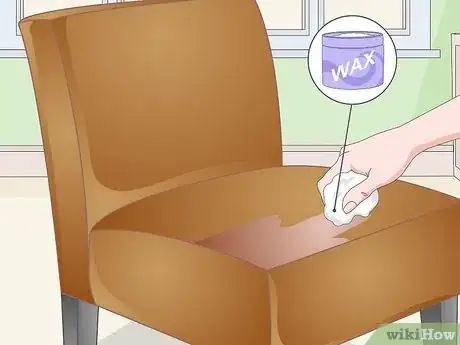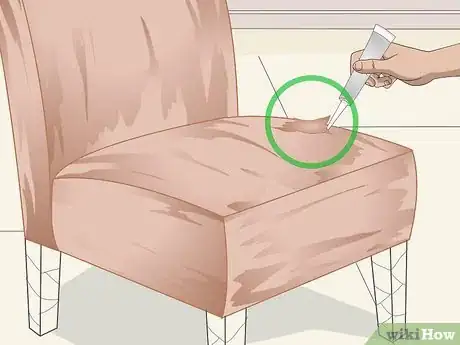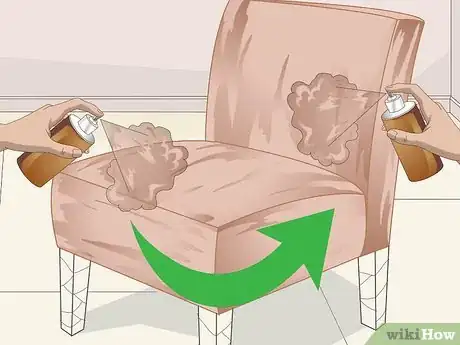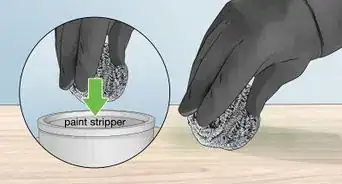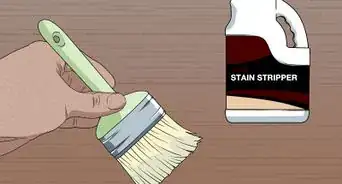This article was co-authored by Mallika Sharma. Mallika Sharma is a Certified Leather Care Technician and the Founder of The Leather Laundry, a niche spa service for luxury leather gear in India. Mallika specializes in leather cleaning, coloring, repairing, and restoring for shoes, handbags, jackets, wallets, belts, and sofas. She holds a Master’s degree in Finance and Investment from the University of Edinburgh Business School. Mallika is a certified Professional Leather Care Technician and trained with the globally reputed leather care company, LTT in the United Kingdom.
There are 9 references cited in this article, which can be found at the bottom of the page.
This article has been viewed 40,202 times.
You have an old leather couch that just isn't pulling its weight anymore. It's looking weathered and beat up, and you're ready to throw it out. Then you come across an idea: paint it! It sounds crazy, but it just might work. Start off by picking the kind of paint you want to use. Picking one made for leather is likely your best bet, but you have a few other options. Make sure your couch is ready to paint, and then use some elbow grease to change it into a brand new piece of furniture.
Steps
Choosing Your Paint Supplies
-
1Try a paint made just for leather. For the best results, pick a paint that was designed to go on leather. It will have a more polished look at the end, and it will likely have the smoothest surface. Plus, that type of paint will bond best with leather.[1]
- Try Angelus brand leather paint or ReLuv.
-
2Make your own fabric paint. Some people make a paint mixture themselves to use on their couch. This option will likely cover your couch and be durable, but it's not going to give you as smooth a finish as leather paint will.[2]
- Try a "chalkboard" paint. The advantage of this paint is that it's highly durable and relatively cheap. Just mix two parts powdered calcium carbonate with one part water and four parts latex paint, then use as normal. You can find calcium carbonate online or at some home improvement stores.
- You can also use textile medium. For each quart of latex paint, mix in two 8-ounce bottles of textile medium. You can find textile medium at most craft stores. It makes the paint dry softer and more flexible, and it also helps it bond to the leather.[3]
- Another option is using a paint mixture of two-thirds store-bought chalkboard paint and one-third water to create a thinner paint that you can use on leather.[4]
Advertisement -
3Use spray paint. Spray paint may not be the obvious choice when it comes to painting leather. However, it can work, particularly on something you don't use very much. It will take some patience to use spray paint, so be ready for the time commitment.
- Pick a paint meant for multiple surfaces.
-
4Pick a brush. The type of brush you choose depends on the texture of your couch. For instance, a typical cheap foam brush will work on a smoother surface. A relatively smooth sponge will also work.[5] If your couch has fine cracks, though, a sturdy paintbrush might work better.[6]
- If you do choose a standard brush, pick a brush with a fine or synthetic bristle to help cut back on brush lines.[7]
Painting the Couch with a Brush or Sponge
-
1Prepare the couch for painting. Start by taking off any cushions you can to make the couch easier to paint.[8] In addition, tape off any areas that you don't want covered in paint, such as wooden legs. Use painters tape to tape off these areas.
-
2Layer thin coats. One way to help keep the paint supple and smooth is to create thin layers, particularly if you're using a paint you made yourself. The thin layers will help keep the paint from cracking, as well. Of course, that means more work overall, but the end result will be better.[11]
- Don't gob large amounts of the paint on the couch at a time. Create very thin, quick-drying layers.
-
3Use three or four layers. It will take a number of layers to get your couch covered with paint, so be patient. Start with three layers, but you may need as many as six layers to get the couch covered, along with a bit of touch up.[12]
- Let the sofa dry completely between coats. The paint should be dry to the touch and not have any shiny spots.[13]
-
4Alternate directions. As you paint the couch, alternate the way you are painting. That is, on one coat, make your strokes go in one direction. On the next coat, make your strokes go perpendicular to the first layer. This process creates a smoother, stronger surface.[14]
- Some people find a circular motion works better. Test your pattern in an inconspicuous place first before applying it to the whole couch.
-
5Let it cure. Once you have the paint on how you'd like, just leave it alone. Let it set for at least two days before you try anything else on it. In fact, do not touch it or move the leather around. Just let it be so the paint has a chance to cure.[15]
-
6Sand the paint if needed. Some paints can leave the top feeling rough, particularly if they're not made for leather. To alleviate this problem, sand down the paint once it has set. Start with rougher sandpaper and work down to finer paper. Use your hand to decide when the paint is the right texture.[16]
- Wipe or vacuum any dust that collects as you sand.
-
7Try a finish. In some cases, a finish can be helpful. For most leather paints, a finish is necessary. Choose from high gloss, semi-gloss, or matte, depending on the look you want for your couch. Apply a layer of the gloss at the end of the project.[17]
- Some people find that using wax over a homemade paint can add durability and shine. However, it's not absolutely necessary.[18]
Using Spray Paint
-
1Prepare the couch. Once again, take the cushions off the couch.[19] Also, tape off any areas you don't want to get spray paint on, using painter's tape. Tape those areas off thoroughly, as spray paint has a tendency to drift.
- Glue together any major cracks or use a patch. Sand the area down before painting.[20]
-
2Apply the paint. Create thin layers of spray paint on the paintable areas. Thin layers are very important when it comes to leather. Hold the spray paint well above the area, moving it around slowly to create an even, light layer. Start in an inconspicuous area to test what it looks like.
-
3Let it dry between coats. Spray paint can become tacky and peel if you don't let it dry between layers. Make sure the painted area is completely dry before you add the next layer. You may need as many as twenty layers when painting a couch with spray paint.
-
4Wipe it off. Once the couch has an appearance you like, stop adding layers. Let it dry completely. Leave it to cure for about at least two days, so you know it's completely dry and cured. Use a soft cloth to rub down the painted area so that you remove any paint that didn't get absorbed.
References
- ↑ https://www.apartmenttherapy.com/diy-project-results-can-you-paint-a-leather-sofa-233457
- ↑ http://providenthomedesign.com/2015/01/18/paint-couch-diy-chalk-paint/
- ↑ http://www.happinessishomemade.net/diy-painted-sofa-couch/
- ↑ https://rowespurlingpaintcompany.wordpress.com/2016/01/04/painting-leather-with-chalk-paint-by-annie-sloan-part-1/
- ↑ https://www.apartmenttherapy.com/diy-project-results-can-you-paint-a-leather-sofa-233457
- ↑ http://providenthomedesign.com/2015/01/18/paint-couch-diy-chalk-paint/
- ↑ https://rowespurlingpaintcompany.wordpress.com/2016/01/04/painting-leather-with-chalk-paint-by-annie-sloan-part-1/
- ↑ http://providenthomedesign.com/2015/01/18/paint-couch-diy-chalk-paint/
- ↑ http://providenthomedesign.com/2015/01/18/paint-couch-diy-chalk-paint/
- ↑ https://rowespurlingpaintcompany.wordpress.com/2016/01/04/painting-leather-with-chalk-paint-by-annie-sloan-part-1/
- ↑ https://rowespurlingpaintcompany.wordpress.com/2016/01/04/painting-leather-with-chalk-paint-by-annie-sloan-part-1/
- ↑ https://www.apartmenttherapy.com/diy-project-results-can-you-paint-a-leather-sofa-233457
- ↑ https://rowespurlingpaintcompany.wordpress.com/2016/01/04/painting-leather-with-chalk-paint-by-annie-sloan-part-1/
- ↑ https://rowespurlingpaintcompany.wordpress.com/2016/01/04/painting-leather-with-chalk-paint-by-annie-sloan-part-1/
- ↑ https://rowespurlingpaintcompany.wordpress.com/2016/01/04/painting-leather-with-chalk-paint-by-annie-sloan-part-1/
- ↑ http://providenthomedesign.com/2015/01/18/paint-couch-diy-chalk-paint/
- ↑ https://www.apartmenttherapy.com/diy-project-results-can-you-paint-a-leather-sofa-233457
- ↑ http://providenthomedesign.com/2016/02/05/4602/
- ↑ http://providenthomedesign.com/2015/01/18/paint-couch-diy-chalk-paint/
- ↑ https://rowespurlingpaintcompany.wordpress.com/2016/01/04/painting-leather-with-chalk-paint-by-annie-sloan-part-1/
